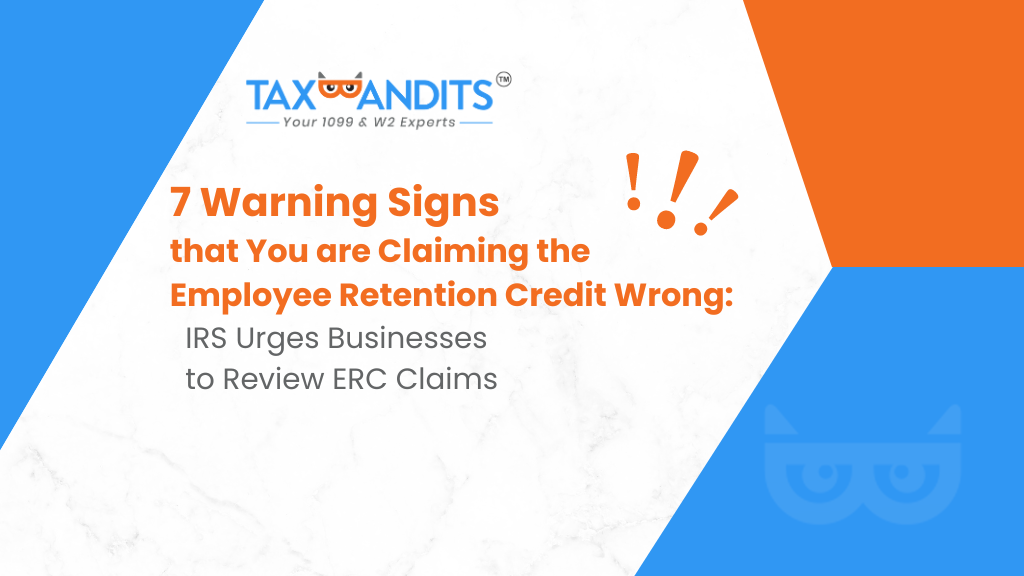7 Warning Signs that You are Claiming the Employee Retention Credit Wrong.

The IRS Urges Businesses to Review ERC Claims
In response to the economic uncertainties brought about by the COVID-19 pandemic, the Employee Retention Credit (ERC), also known as the Employee Retention Tax Credit (ERTC), emerged as a crucial lifeline for businesses. These refundable tax credits were designed to encourage employers to continue paying their employees during the crisis, providing much-needed economic relief during challenging times.
However, the complexities of the ERC have proven to be a daunting task for many businesses. Despite its intended purpose, the ERC has become inundated with false claims, with many employers either inaccurately claiming the credits or claiming an excessive amount because of aggressive marketing by third-party promoters.
To address this issue, the IRS has sharply increased compliance efforts through audits and investigations, with plans for further action in the future. To assist businesses that may have been misled, the IRS has implemented a special program called the voluntary disclosure program, including a limited-time offer for employers to correct improper ERC claims at a discounted rate until March 22, 2024.
According to the IRS, this program may be re-opened depending on decisions from Congress. In the meantime, businesses that still have unprocessed ERC claims can continue to withdraw.
Under the voluntary disclosure program, taxpayers have the opportunity to rectify erroneous ERC claims by repaying only 80% of the received credits and avoiding certain penalties and interest. Additionally, businesses with pending claims can utilize a special claim withdrawal process to address any discrepancies.
The IRS has identified seven common “red flags” to help businesses identify potential issues with their ERC claims. Taking proactive steps now to resolve any inaccuracies can help businesses avoid future IRS actions and ensure compliance with ERC regulations.
#1 – Overclaiming Quarters:
Some businesses have been advised to claim the ERC for all available quarters, regardless of their eligibility. However, eligibility for the ERC varies from quarter to quarter and depends on specific criteria, such as changes in revenue and government orders.
Claiming the ERC for quarters where eligibility criteria are not met can lead to potential penalties and repayment obligations. Therefore, it’s crucial to review your eligibility for each quarter carefully and ensure that your claim aligns with IRS guidelines.
#2 – Misinterpreting Government Orders:
One common misconception is that businesses can claim the ERC based on any government order, regardless of its impact on operations. However, to qualify for the ERC under government order rules, the order must have resulted in the full or partial suspension of the business’s operations due to the COVID-19 pandemic.
Additionally, the government order must be specific and enforceable, rather than merely a recommendation or guidance. It’s essential to carefully review the details of any government orders affecting your business and ensure that they meet the necessary criteria for ERC eligibility.
#3 – Incorrect Calculations
ERC calculations can be complex and depend on various factors, including changes in legislation and wage limits. Some businesses may inadvertently overclaim the ERC by miscalculating eligible wages or failing to account for changes in legislation.
To avoid these errors, it’s crucial to double-check your calculations and ensure that you’re following the most up-to-date IRS guidance. Consulting with a trusted tax preparer can help ensure that your calculations are accurate and compliant.
#4 – Unsupported Supply Chain Issues:
While supply chain disruptions can impact business operations, they do not automatically qualify a business for the ERC. To claim the ERC based on supply chain issues, the disruption must be directly linked to government orders related to the COVID-19 pandemic.
Additionally, businesses must provide documentation to support their claim and demonstrate how the supply chain disruption resulted in the suspension of operations. It’s essential to carefully review the rules and requirements related to supply chain disruptions and ensure that your claim is supported by adequate documentation.
#5 – Making Claims for Multiple Tax Quarters
Some businesses may mistakenly claim the ERC for entire tax quarters, rather than for the specific periods of suspension due to government orders. This can result in overclaiming the credit and may lead to penalties or repayment obligations.
To avoid these issues, it’s important to carefully review your claim and ensure that you’re only claiming the ERC for wages paid during periods of government-ordered suspension. Keeping detailed payroll records can help support your claim and demonstrate compliance with IRS guidelines.
#6 – Claims for Periods When No Wages Were Paid
The ERC can only be claimed for periods when wages were paid to employees. Some businesses may incorrectly claim the ERC for periods where no wages were paid or for periods before the business existed.
These claims are invalid and may result in penalties, repayment obligations, and potential audits by the IRS. To ensure compliance, businesses should carefully review their payroll records and ensure that their ERC claims accurately reflect periods of employee wages.
#7 – Misleading Promoter Claims:
Businesses should be cautious of promoters who downplay the risks of incorrect ERC claims and suggest that there is nothing to lose by claiming the credit. In reality, incorrect claims can result in repayment obligations, penalties, and potential audits by the IRS. It’s essential to conduct thorough research and consult with tax professionals to ensure that your ERC claim is accurate and compliant with IRS regulations.
Key Takeaways:
As a business, it’s crucial to stay informed, vigilant, and compliant with IRS guidelines. By understanding the eligibility criteria and avoiding common errors, businesses can maximize the benefits of the ERC while minimizing the risk of penalties and repayment obligations.
Utilizing IRS resources, consulting with a trusted tax preparer, and maintaining accurate records can help ensure that your ERC claim is accurate, compliant, and beneficial for your business.
793 total views, 3 views today




